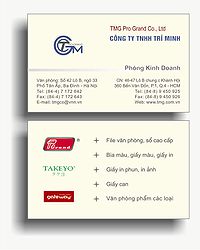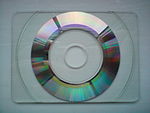- Business card
-
Business cards are cards bearing business information about a company or individual. They are shared during formal introductions as a convenience and a memory aid. A business card typically includes the giver's name, company affiliation (usually with a logo) and contact information such as street addresses, telephone number(s), fax number, e-mail addresses and website. It can also include telex, bank account and tax code. Traditionally many cards were simple black text on white stock; today a professional business card will sometimes include one or more aspects of striking visual design.
Contents
Construction
Business cards are printed on some form of card stock, the visual effect, method of printing, cost and other details varying according to cultural or organizational norms and personal preferences. The common weight of a business card varies some by location. Generally, business cards are printed on stock that is 350 g/m² (density), 45 kg (100 lb) (weight), or 12 pt (thickness).
High quality business cards without full-color photographs are normally printed using spot colors on sheet-fed offset printing presses. Some companies have gone so far as to trademark their spot colors (examples are UPS brown, Los Angeles Lakers' purple, and Tide's orange).[citation needed] If a business card logo is a single color and the type is another color, the process is considered two color. More spot colors can be added depending on the needs of the card. With the onset of digital printing, and batch printing, it is now cost effective to print business cards in full color.
To simulate the "raised-print" effect of printing with engraved plates, a less-expensive process called thermography was developed that uses the application of a plastic powder, which adheres to the wet ink. The cards are then passed through a heating unit, which melts the plastic onto the card. Spot UV varnish onto matte laminate can also have a similar effect.
Full color cards, or cards that use many colors, are printed on sheetfed presses as well; however, they use the CMYK (cyan, magenta, yellow, and black) four-color printing process. Screens of each color overprinted on one another create a wide gamut of color. The downside to this printing method is that screened colors if examined closely will reveal tiny dots, whereas spot color cards are printed solid in most cases. Spot colors should be used for simple cards with line art or non-black type that is smaller than 5 points.
Some terminology in reference to full-color printing:
- 4/0 - Full Color Front / No Print On Back
- 4/1 - Full Color Front / One color On reverse
- 4/4 - Full Color Front / Full Color Back
These names are pronounced as "four over zero," "four over one," or in some cases "four over four".
A business card can also be coated with a UV glossy coat (offset-uv printing). The coat is applied just like another ink using an additional unit on a sheetfed press. That being said, UV coats can also be applied as a spot coating - meaning areas can be coated, and other areas can be left uncoated. This creates additional design potential.
Business cards can also be printed with a digital copier, which uses toner baked onto the surface of the card. Some industry leaders have begun to avoid using the term "copier" in their literature, insisting their state-of-the-art machines are more like digital presses, than their office-oriented predecessors.
While some of the older office copiers may have had problems running heavy business card stock, the newest digital presses can print on stock as heavy as 80# to 100# cover stock, and 12 to 14 point stocks with ease.
UV coats, and other coatings such as Aqueous Coatings are used to speed manufacturing of the cards. Cards that are not dry will "offset" which means the ink from the front of one card will end up on the back of the next one. UV coatings are generally highly glossy but are more likely to fingerprint, while aqueous coatings are not noticeable but increase the life of the card. It is possible to use a dull aqueous coating on uncoated stock and get some very durable uncoated cards, and using UV coating or plastic lamination can also be applied to thicken thin stocked cards and make them more durable as well.
When cards are designed, they are given bleeds if color extends to the edge of the finished cut size. (A bleed is the extension of printed lines or colors beyond the line where the paper it is printed on will be cut.) This is to help ensure that the paper will cut without white edges due to very small differences in where the blade cuts the cards, and it is almost impossible to cut the cards properly without. Just being a hair off can result in white lines, and the blade itself will pull the paper while cutting. The image on the paper can also shift from page to page which is called a bounce, which is generally off by a hairline on an offset press, but can be quite large on lower end equipment such as a copier or a duplicator press. Bleeds are typically an extra 3.175 (1⁄8) to 6.35 mm (1⁄4 in) to all sides of the card.
- Bleed size: 95.25 × 57.15 mm (3.75 × 2.25 in) (1⁄8 in bleeds)
- Standard cut size: 89 × 51 mm (3.5 × 2 in)
Fold-over or "tent" cards, and side fold cards are popular as well. Generally these cards will fold to the standard size.
In today's global marketplace, cards often are printed with English on one side and the local language (if not English) on the other.
Dimensions
Aspect ratios range from 1.42 to 1.8.
Country/Standard Dimensions (mm) Dimensions (in) Aspect ratio ISO 216, A8 sized 74 × 52 2.913 × 2.047 1.423 Ireland, Italy, United Kingdom, France, Germany, Austria, Netherlands, Spain, Switzerland, Belgium 85 × 55 3.346 × 2.165 1.545 ISO/IEC 7810 ID-1, credit card sized 85.60 × 53.98 3.370 × 2.125 1.586 Australia, Denmark, New Zealand, Norway, Taiwan, Sweden, Vietnam 90 × 55 3.54 × 2.165 1.636 Japan 91 × 55 3.582 × 2.165 1.655 Hong Kong, China, Singapore 90 × 54 3.543 × 2.125 1.667 Canada, United States 88.9 × 50.8 3.5 × 2 1.75 Iran 85 × 48 3.346 × 1.889 1.771 Argentina, Brazil, Czech Republic, Finland, Hungary, Israel, Kazakhstan, Poland, Romania, Russia, Serbia, Montenegro, Slovakia, Slovenia, Ukraine, Uzbekistan, Bulgaria, Latvia, Mexico and South Africa 90 × 50 3.543 × 1.968 1.8 Other formats
Recent technological advances have made Compact Disc "business cards" possible, which can hold about 35 to 100 MB of data. These Business Card CDs may be square, round or oblong but are approximately the same size as a conventional business card. CD business cards are designed to fit within the 80 mm tray of a computer's CD-ROM drive. They are playable in most tray computer CD drives, but do not work in slot-loading drives. Despite the ability to include dynamic presentations and a great deal of data, these discs are not in common use as business cards.
Most handheld computers have the ability to wirelessly transmit (through either infra-red or Bluetooth or RFID) an electronic business card, eliminating the need for the recipient to re-key the contact information.[citation needed] This is also done via SMS.
Business card data are increasingly becoming a part of assorted digital media.[1]
Special materials
Apart from common business cards made of paper/card there are also special business cards made from plastic (PVC), especially frosted translucent plastic, crystal clear plastic, white or metallic plastic. Other extraordinary materials are metal, rubberized cards, rubber, magnets, poker chips, wooden nickels, and even real wood. For the most part those special material business cards are of standard format, sometimes with rounded corners. These new materials are popular among companies that wish a unique and eye-catching look.
Business card software
Business cards can be mass produced by a printshop or printed at home using business card software. Such software typically contains design, layout tools, and text editing tools for designing one's business cards. Most business card software integrates with other software (like mail clients or address books) to eliminate the need of entering contact data manually. Cards are usually printed on business card stock or saved in an electronic form and sent to a printshop. Multiple programs are available for users of Linux, Mac and Windows platforms.
Web-to-Print
In addition to business card software, many printing firms now offer a web-to-print service, which allows the customer to choose from a selection of stock design templates, customise online using their own logos and imagery, select quantities, view pricing options and request them for delivery to home or business addresses. Often this process is applied not only to business cards, but also to letterheads, notepads, labels and compliments slips.
Collecting
There are several hundred known collectors of business cards, especially antique cards, celebrity cards, or cards made of unusual materials. One of the major business card collectors' clubs is the International Business Card Collectors, IBCC. IBCC members exchange cards with other members, simply for the price of postage. Collectors often shorten the words "business card" to BC to make e-mail discussion easier.[citation needed]
See also
References
Categories:- Business cards
- Stationery
- Ephemera
- Paper products
Wikimedia Foundation. 2010.



